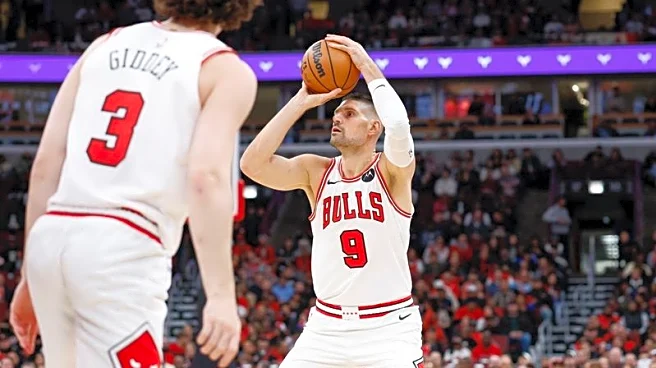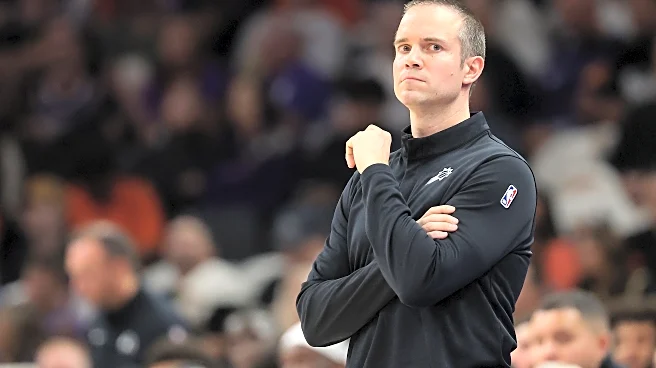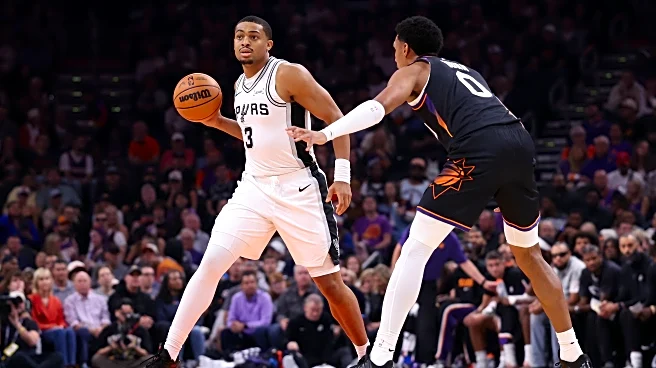I find myself in an interesting spot. All season, I’ve been preaching patience, saying the Suns should be careful about tossing their rookies into deep water too soon. Development isn’t about minutes alone,
it’s about context, rhythm, and opportunity. Put a player in the wrong spot too early, and you risk bruising confidence before it ever hardens.
I think back to Sunday night against the Spurs, when the Suns had to deal with the 7’5” riddle that is Victor Wembanyama. You could make the case for rolling out 7’2” Khaman Maluach to match size with size, guard length with length. It sounds logical in theory, but it’s the kind of logic that falls apart the moment the ball tips. Wembanyama thrives on that matchup. He’s used to it. He bends size to his will, using it against whoever dares to challenge him.
If the Suns had gone that route, it wouldn’t have helped Maluach’s growth. It would’ve shaken it. Instead of learning through controlled fire, he’d be tossed into a storm he wasn’t ready for. Going small and swarming from within made more sense. It played to the team’s strengths and kept the rookie’s confidence intact for another day.
What the Suns can do now is use the film they’ve built through these first few games as a teaching tool, a blueprint for their rookies to study and replicate in practice. It’s one thing to explain how a defensive rotation should work. It’s another to show it, frame by frame, where it clicked and where it broke down. Let the young guys see it, feel it, learn from it in the film room, instead of being the ones living those mistakes on the floor.
But still, I catch myself hearing the noise and nodding along. I’m trying to do what Toto says.I’m trying to hold the line. But man, it’s getting harder by the game. And it’s because of Oso Ighodaro.
We’ve said it before, and it’s still true: Ighodaro is a thinker. He plays with the kind of vision you want from any big man in the league. He sees the floor, reads the defense, and makes quick decisions that keep the offense flowing. Give him the ball at the top of the key, and you can run dribble handoffs, back cuts, all kinds of motion through him.
But one thing you can’t do is have him spot up from 18 feet and expect the defense to care. There’s no gravity there, no pull.
The more we see Jordan Ott run sets through Oso, the more it feels like we’re learning his limits in real time. It feels detrimental to the team’s success, especially when he’s playing center. The spacing collapses, the paint clogs, and what should be fluid possessions start to feel stuck in mud. It’s not for lack of effort or IQ. It’s that his game doesn’t stretch the floor, and in today’s NBA, that can grind an offense to a halt.
The numbers tell the story.
He’s started 4 of the Suns’ 8 games, averaging 17.8 minutes, 4.8 points, and 3.4 rebounds. His field goal percentage, once a clean 60.4% as a rookie, has dropped to 42.2%. Turnovers have climbed from 0.6 to 1.6. His assist-to-turnover ratio has fallen from a respectable 1.82 to 0.77. For a player whose value lives in facilitation, that’s a problem.
He is a -33 this season, second-worst on the team, only behind the -51 of Nigel Hayes-Davis. His rebounding percentage is 8.9% (for reference, Mark Williams is at 18.9% and Nick Richards is at 16.4%).
Per Basketball Reference, 18% of his minutes have come at power forward, 83% at center. That’s where the conundrum starts. That’s where the frustration brews. Because when you put a player built to connect the offense in a role that demands dominance, the seams start to show.
I feel like Oso is caught in the same strange basketball purgatory that swallowed Bol Bol. Not in skill set, but in spirit. That in-between space where a player doesn’t quite fit anywhere. Bol had otherworldly length, but not enough weight to matter on the block. You could bump him off his spot with a stiff breeze. So he drifted to the perimeter, but he wasn’t quick enough to survive there either. Too big to be a wing, too light to be a big. That’s basketball limbo.
Oso lives there now. He can block shots — he’s 4th on the team with 5 this season — but he doesn’t have the kind of length that terrifies anyone. He’s got the weight to bang down low, yet he still gives up ground. Pull him out to the perimeter, and guards treat him like an open buffet. You could see Steph Curry salivating last night in Golden State, licking his chops at the chance to cook him in isolation.
And that’s before we even touch offense. His shot chart looks like a coloring book with one crayon. Everything’s clustered around that push shot, and there’s been no sign of expansion. If he had even a hint of range, you could float him as a stretch four and get away with it. But without that, paired with average rebounding, you’re left with a cerebral player who sees the game clearly but struggles to bend it to his will.

And that’s where it gets tough to keep holding the line this far into the season.
Eight games in, Jordan Ott is starting to show us his tactical fingerprints, and part of that print has way too much Oso Ighodaro for my liking. It’s his second season, and yes, he’s the project on the workbench. The lab experiment. The player the team wants to give runway to, see what sticks, see where he fits, maybe even convince themselves there’s more there than we’ve seen.
But when those minutes fall flat, it’s hard not to glance down the bench. Because sitting there are two rookies who, at least on paper, fill the very gaps Oso leaves behind.
Khaman Maluach has the length and size to protect the paint in a way Oso can’t. He can shoot the three, which opens the floor in ways Oso doesn’t. And then there’s Rasheer Fleming, who has that 7’5.25” wingspan (Oso’s wingspan? 6’11”) and athleticism with a jumper that’s always lurking. Sure, he’s been streaky — 34.9% from deep in college, 39.0% in Summer League, 30.8% in preseason — but he’s a threat. A defender has to respect him.
Oso doesn’t give you that. He’s a connector, not a creator, and that’s fine in spurts. But when the offense bogs down and the defense starts leaking, those rookies start to look a lot more tempting.
I want Oso to make it. You can tell Jordan Ott does too. He’s giving him every chance to show something, to prove he belongs. But that tingling on the back of your neck? Yeah, we’ve all felt it. The same one Haley Joel Osment felt every time Bruce Willis walked into a room. It feels like we’re watching a ghost. Like Oso is slowly playing himself off the floor instead of onto it.
What makes it worse is seeing two rookies sitting there, helmets on, ready to go, collecting DNPs while Oso struggles through another 17-minute stint. Those minutes could be carved into small developmental windows, little test drives for Khaman Maluach or Rasheer Fleming to get their feet wet. It wouldn’t take much. Split those minutes, let them learn.
But then you come back to the developmental plan. If those are high-leverage minutes — moments that could burn confidence instead of build it — maybe this slow roll makes sense. That’s the Catch-22. You either risk damaging the kids, or you keep watching Oso’s tape hoping the picture changes.
We’ve got 74 games to go, and there’s no doubt we’ll see the rookies soon enough. But right now, the Oso experiment feels like it’s producing the kind of fruit you quietly throw away when no one’s looking. He’s fundamentally sound, but the impact isn’t there. When your net rating sits at -33, it’s hard not to wonder if letting the rookies run could really make things any worse.
When you look at the top 10 overall picks in the draft last season, Maluach is easily at the bottom of the list relative to total minutes played.
- Cooper Flagg – 229 MP
- Dylan Harper – 140 MP
- VJ Edgecombe – 271 MP
- Kon Knueppel – 243 MP
- Ace Bailey – 122 MP
- Tre Johnson – 180 MP
- Jeremiah Fears – 176 MP
- Egor Demin – 119 MP
- Collin Murray-Boyles – 128 MP
- Khaman Maluach – 23 MP
I get it. Bigs take time. They grow slower, move through the game like clay that still needs shaping. And Oso is only 19. But when you need a rebound, when you need the floor stretched and the paint cleared, you’re not calling his name. Not yet.
We’ll see where it goes from here. What makes things interesting is that the G League season tips off November 8, and that changes everything. With this much youth on the roster, it’s the perfect chance to get guys live reps without throwing them into the fire every night. Maybe that means the rookies get their first real run. Maybe Oso gets a stint down in Tempe to polish the edges and rebuild confidence.
It could be that this early stretch was always meant to be a test run, a window to see what your sophomore big really has. Once the G League doors open, the options multiply. You can keep nurturing his development, give the rookies a crack at those bench minutes, and see who starts to separate from the pack.
In the end, this is the part of the season where patience and curiosity wrestle each other every night. You want to see the kids run, to see the future take shape, but you also know growth rarely happens in a straight line.
Maybe this is all part of the process, the slow burn before the spark. Maybe Oso finds his rhythm and becomes the steady hand the team hoped for. Or maybe the door creaks open for Khaman and Rasheer to take their first real steps into the fire. Either way, something’s about to give. You can feel it in the rhythm of these early games, in the long stares down the bench, in the restless hum of potential waiting to break through.













